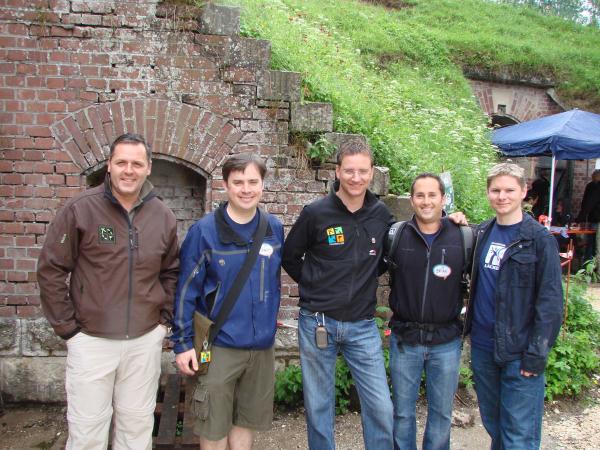Celebrating 10 Years in Germany

In an area next to Ulm University, a short drive away from Stuttgart, Germany, is a 130 year old abandoned fort occupied by a few sheep, some goats and a donkey named Paul.

It was here on June 19th that local geocachers hosted Das Ulmer FORT – the Mega Event in Germany for 2010 (GC20002).
Six months ago the local geocaching community started preparations for the event. The fort had been neglected for 30 years, so an army of volunteers had to dig out the, err, deposits left by the local residents. The electricity had to be rewired, sharp protrusions had to be cut down and sanded, repairs had to be made, rooms had to be swept out, and trash had to be removed. This was necessary to make the location capable of holding over 300 campers who resided in the walls of the fort for the weekend.
Elias, Bryan and I, the three founders of Geocaching.com, had the privilege of attending the event this year.


In the course of four hours we were able to mingle with the local geocachers, visit the various rooms and corridors in the Fort, meet the lovely Queen of Fort Ulm and celebrate a successful day with the organizers by eating a delicious Signal cake.

It’s not often that we can visit geocachers in Europe, so we used this opportunity to listen to feedback about the web site. High on the list was having better ways to rate and search for geocaches by their ratings, which has been a common theme in the US. As geocaches increase in numbers it gets harder and harder to find the best ones.
Although geocachers in the world have far more similarities than differences, there were also some notable observations in how Germans play the game.

1. Many German geocachers enjoy finding terrain level 5 caches, or what are locally called “T5” caches. Many of these caches are located in trees, requiring special climbing gear. The event even had FORTgeschrittene, a T5 event for finding these extreme geocaches. In addition to a ropes course, you could dive into a freezing pool to find a cache. Fortunately you could enter a portable sauna to warm up afterward. Sadly I didn’t pack a bathing suit.

2. According to the “Flashlight Pope” at the event, there are quite a few caches that require a black light. This is so you can see writing that takes you to the next location. As a gift he gave each of us a black light to use on our next geocaching adventure.
3. Multi-Caches are far more popular in Germany (and in Europe) than in the United States. Many more geocachers seem to be willing to spend days on one puzzle cache there. There may be a lot of multi-cache fans in the U.S. but the ratios of multis in Germany to U.S. caches are significantly higher.
Aside from the event we were able to locate unique geocaches in Germany, such as a cache in the center of Berlin with over 3,000 finds (GCTA4W), and a cache in the spire of the world’s tallest church (GCJ7E0), located in the city of Ulm.
If the locals plan on having a FORTsetzung (sequel) next year you don’t want to miss it. Thanks to everyone who planned one of the best geocaching events that we have ever attended. I hope to see you again next year!




